Abstract
Various types of anti-neoplastic agents induce apoptosis in vitro, but less is known of the role of this mode of cell death in tumours treated in vivo. We examined the induction of apoptosis by oral anti-neoplastic agents, tegafur and uracil (UFT, a combined preparation of 1 mol tegafur and 4 mol uracil), and the relationship of effects on tumour growth. Seven different human gastrointestinal tumour xenografts were transplanted into nude mice, including two colon adenocarcinomas (KM20C and Col-1), three gastric carcinomas (SC-6, St-40 and 4-1ST) and two pancreatic carcinomas (PAN-4 and PAN-12), followed by oral administration of UFT (24 mg kg(-1) day(-1)) for 9 days. The percentage of apoptotic cells in each tumour was scored in histological sections, chronologically, using a molecular biological-histochemical system and growth inhibition was examined in each tumour. A significant growth inhibition by UFT was observed for all tumours, except PAN-12. In KM20C and SC-6, growth inhibition rates were 61.7% and 60.6% respectively. Quantitative assay for apoptosis showed a remarkable induction of apoptosis in KM20C (4.2%) and SC-6 (3.5%), which were relatively sensitive to UFT. In addition, KM20C and SC-6 showed a higher incidence of spontaneous apoptosis. In five other tumours, which responded to a lesser extent than KM20C and SC-6, UFT altered little the changes in apoptosis (less than 2%) and spontaneous apoptosis was relatively low. Thus, tumours with a higher apoptosis induced by UFT had a higher response to UFT. Apoptosis observed in tumours might serve as a predictor of a preferable response to UFT.
Full text
PDF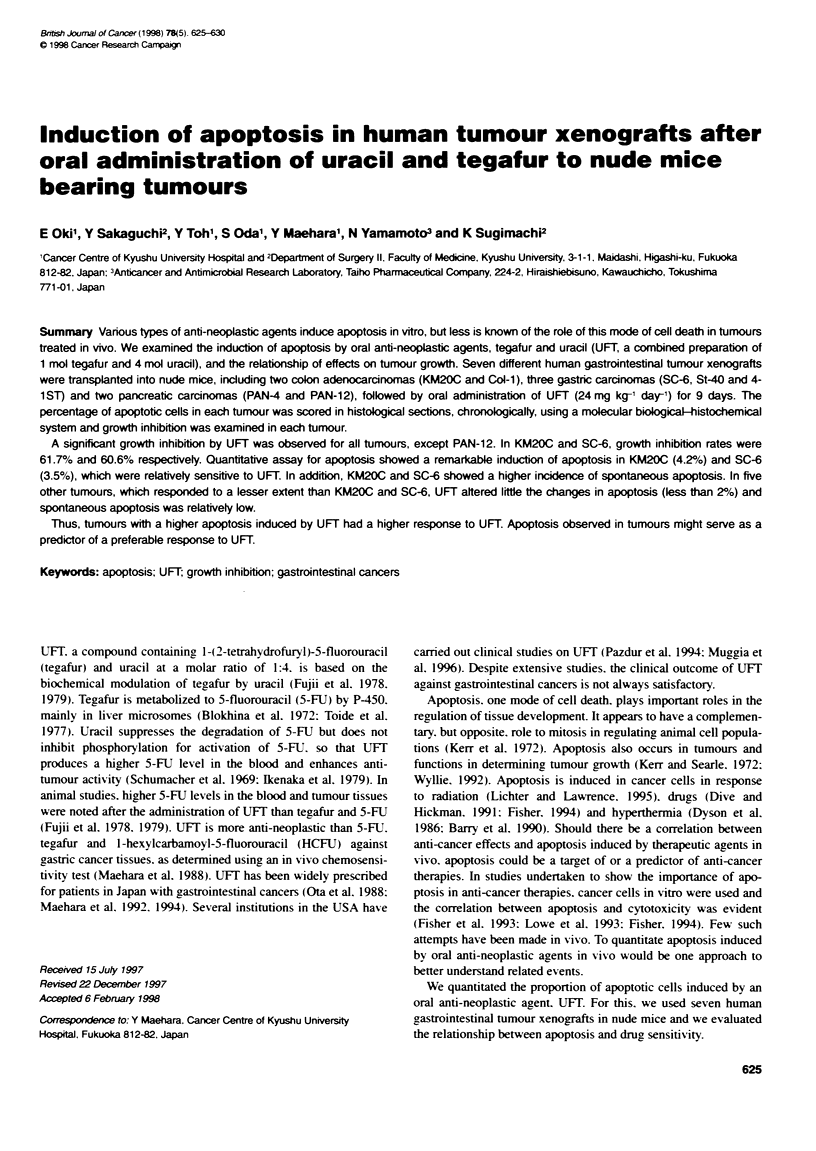
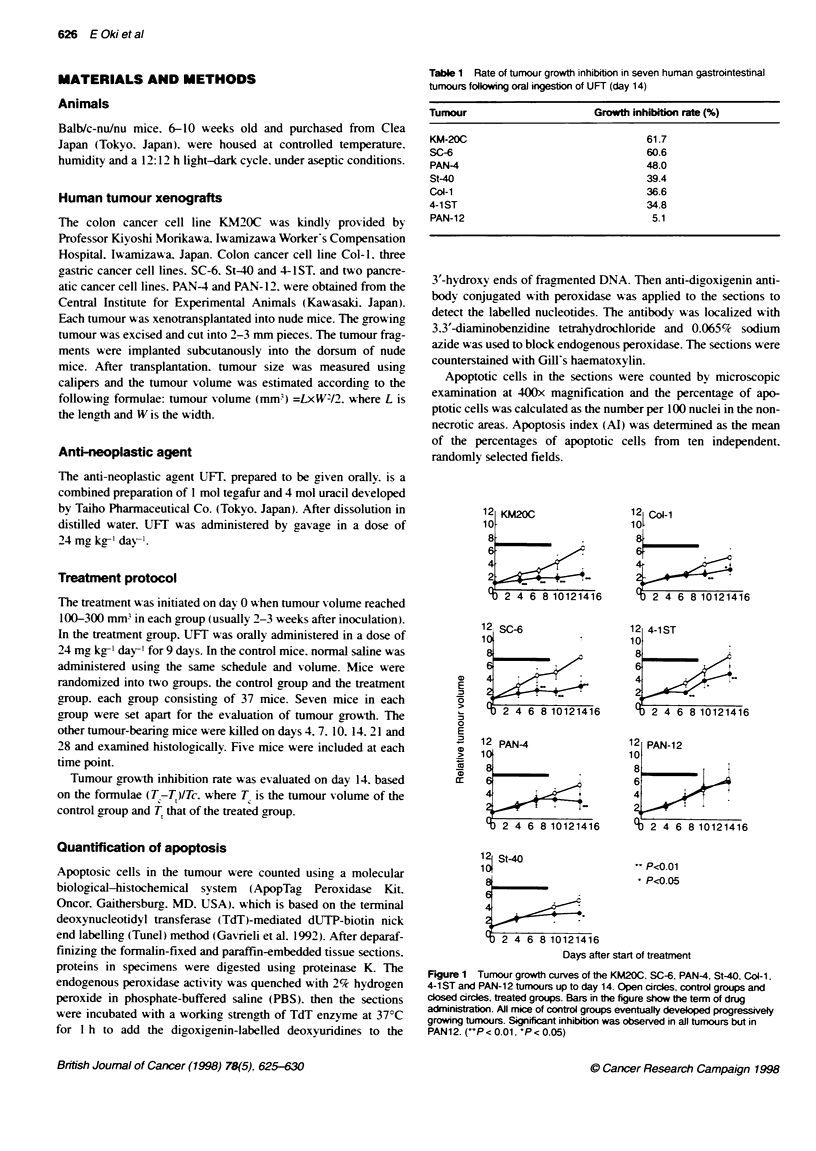
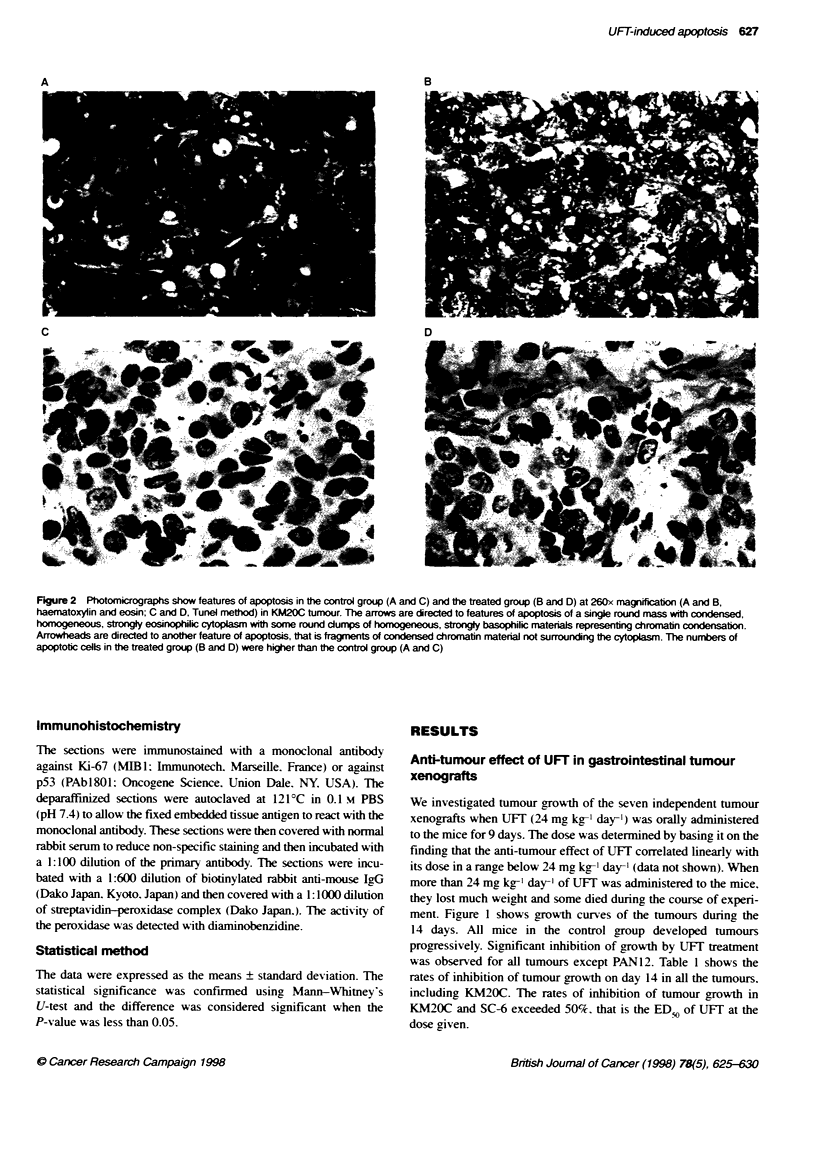
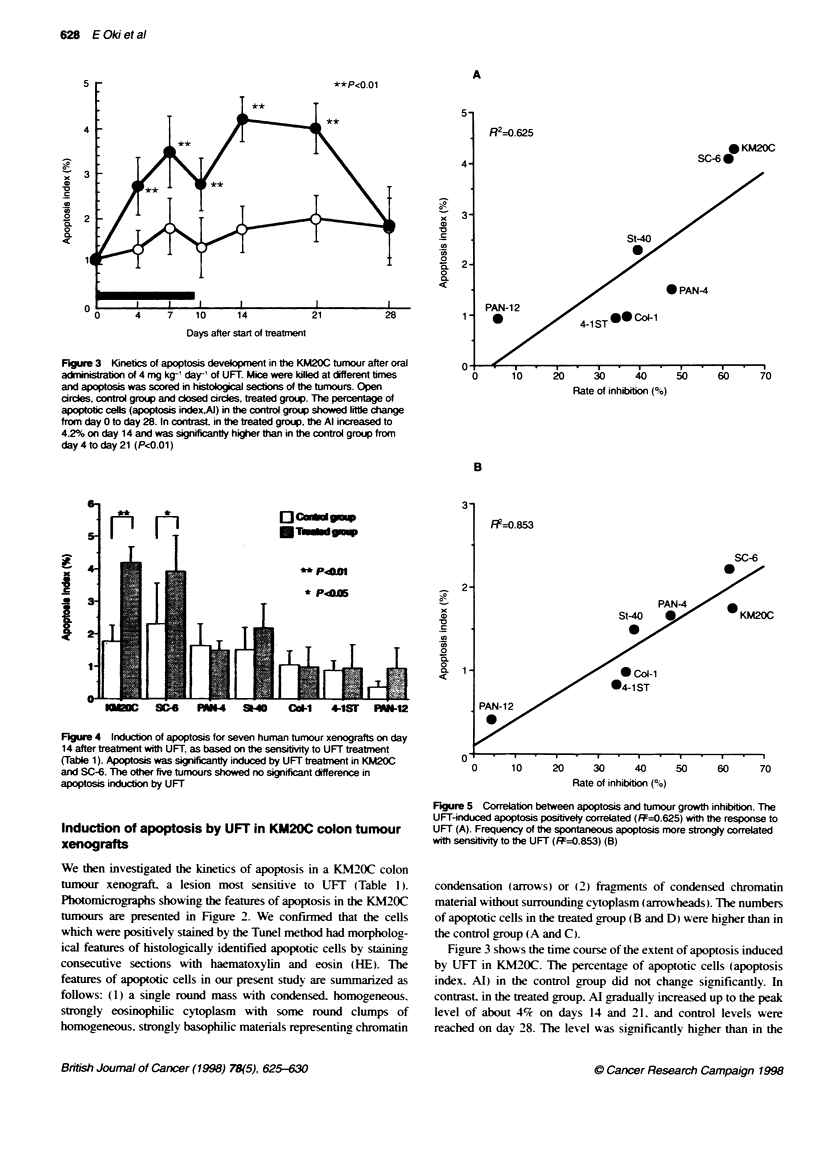
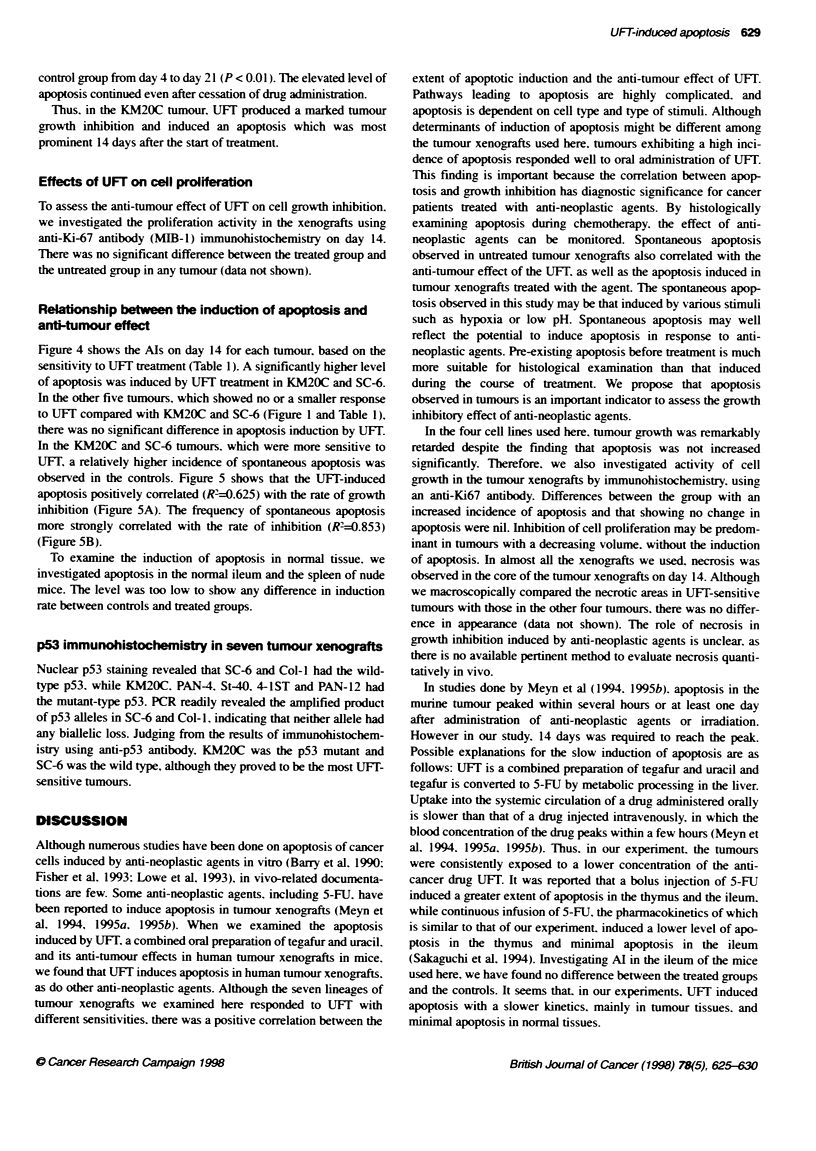
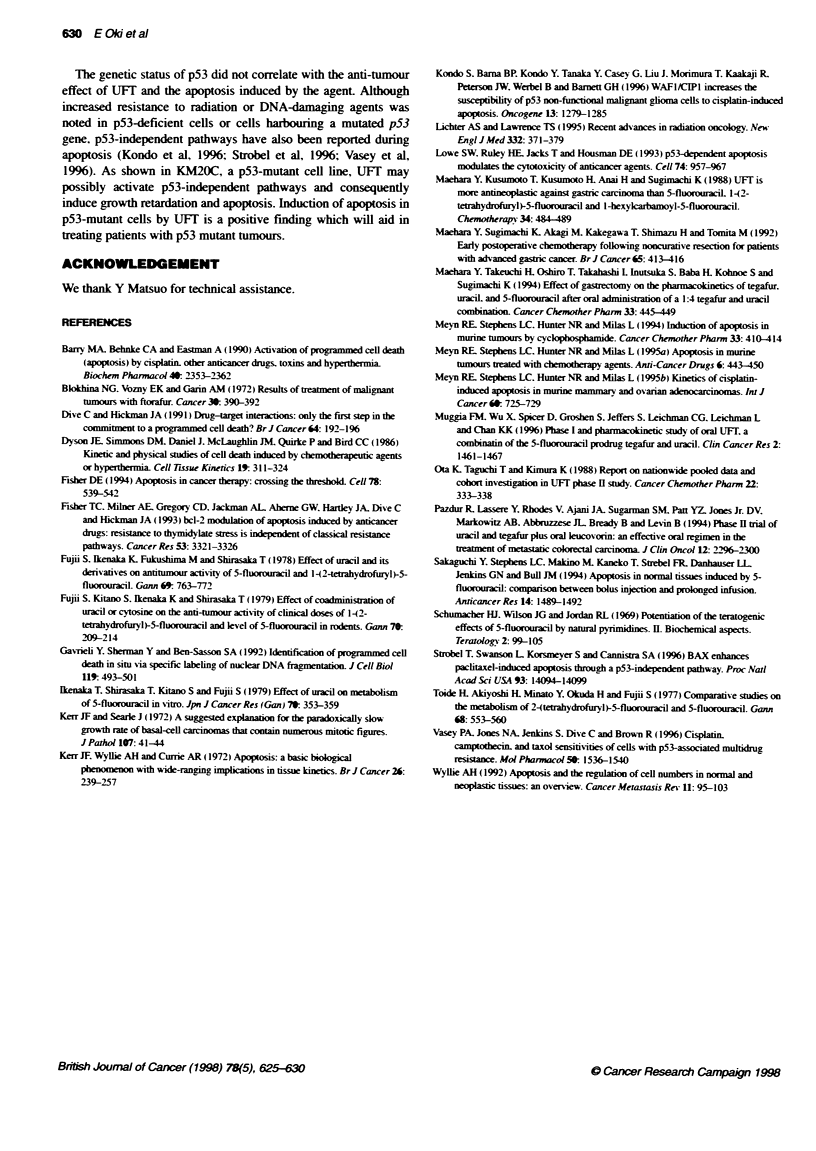
Images in this article
Selected References
These references are in PubMed. This may not be the complete list of references from this article.
- Blokhina N. G., Vozny E. K., Garin A. M. Results of treatment of malignant tumors with ftorafur. Cancer. 1972 Aug;30(2):390–392. doi: 10.1002/1097-0142(197208)30:2<390::aid-cncr2820300214>3.0.co;2-e. [DOI] [PubMed] [Google Scholar]
- Dive C., Hickman J. A. Drug-target interactions: only the first step in the commitment to a programmed cell death? Br J Cancer. 1991 Jul;64(1):192–196. doi: 10.1038/bjc.1991.269. [DOI] [PMC free article] [PubMed] [Google Scholar]
- Fisher D. E. Apoptosis in cancer therapy: crossing the threshold. Cell. 1994 Aug 26;78(4):539–542. doi: 10.1016/0092-8674(94)90518-5. [DOI] [PubMed] [Google Scholar]
- Fujii S., Ikenaka K., Fukushima M., Shirasaka T. Effect of uracil and its derivatives on antitumor activity of 5-fluorouracil and 1-(2-tetrahydrofuryl)-5-fluorouracil. Gan. 1978 Dec;69(6):763–772. [PubMed] [Google Scholar]
- Fujii S., Kitano S., Ikenaka K., Shirasaka T. Effect of coadministration of uracil or cytosine on the anti-tumor activity of clinical doses of 1-(2-tetrahydrofuryl)-5-fluorouracil and level of 5-fluorouracil in rodents. Gan. 1979 Apr;70(2):209–214. [PubMed] [Google Scholar]
- Gavrieli Y., Sherman Y., Ben-Sasson S. A. Identification of programmed cell death in situ via specific labeling of nuclear DNA fragmentation. J Cell Biol. 1992 Nov;119(3):493–501. doi: 10.1083/jcb.119.3.493. [DOI] [PMC free article] [PubMed] [Google Scholar]
- Ikenaka K., Shirasaka T., Kitano S., Fujii S. Effect of uracil on metabolism of 5-fluorouracil in vitro. Gan. 1979 Jun;70(3):353–359. [PubMed] [Google Scholar]
- Kerr J. F., Searle J. A suggested explanation for the paradoxically slow growth rate of basal-cell carcinomas that contain numerous mitotic figures. J Pathol. 1972 May;107(1):41–44. doi: 10.1002/path.1711070107. [DOI] [PubMed] [Google Scholar]
- Kerr J. F., Wyllie A. H., Currie A. R. Apoptosis: a basic biological phenomenon with wide-ranging implications in tissue kinetics. Br J Cancer. 1972 Aug;26(4):239–257. doi: 10.1038/bjc.1972.33. [DOI] [PMC free article] [PubMed] [Google Scholar]
- Kondo S., Barna B. P., Kondo Y., Tanaka Y., Casey G., Liu J., Morimura T., Kaakaji R., Peterson J. W., Werbel B. WAF1/CIP1 increases the susceptibility of p53 non-functional malignant glioma cells to cisplatin-induced apoptosis. Oncogene. 1996 Sep 19;13(6):1279–1285. [PubMed] [Google Scholar]
- Lichter A. S., Lawrence T. S. Recent advances in radiation oncology. N Engl J Med. 1995 Feb 9;332(6):371–379. doi: 10.1056/NEJM199502093320607. [DOI] [PubMed] [Google Scholar]
- Lowe S. W., Ruley H. E., Jacks T., Housman D. E. p53-dependent apoptosis modulates the cytotoxicity of anticancer agents. Cell. 1993 Sep 24;74(6):957–967. doi: 10.1016/0092-8674(93)90719-7. [DOI] [PubMed] [Google Scholar]
- Maehara Y., Sugimachi K., Akagi M., Kakegawa T., Shimazu H., Tomita M. Early postoperative chemotherapy following noncurative resection for patients with advanced gastric cancer. Br J Cancer. 1992 Mar;65(3):413–416. doi: 10.1038/bjc.1992.84. [DOI] [PMC free article] [PubMed] [Google Scholar]
- Maehara Y., Takeuchi H., Oshiro T., Takahashi I., Inutsuka S., Baba H., Kohnoe S., Sugimachi K. Effect of gastrectomy on the pharmacokinetics of tegafur, uracil, and 5-fluorouracil after oral administration of a 1:4 tegafur and uracil combination. Cancer Chemother Pharmacol. 1994;33(6):445–449. doi: 10.1007/BF00686498. [DOI] [PubMed] [Google Scholar]
- Muggia F. M., Wu X., Spicer D., Groshen S., Jeffers S., Leichman C. G., Leichman L., Chan K. K. Phase I and pharmacokinetic study of oral UFT, a combination of the 5-fluorouracil prodrug tegafur and uracil. Clin Cancer Res. 1996 Sep;2(9):1461–1467. [PubMed] [Google Scholar]
- Sakaguchi Y., Stephens L. C., Makino M., Kaneko T., Strebel F. R., Danhauser L. L., Jenkins G. N., Bull J. M. Apoptosis in normal tissues induced by 5-fluorouracil: comparison between bolus injection and prolonged infusion. Anticancer Res. 1994 Jul-Aug;14(4A):1489–1492. [PubMed] [Google Scholar]
- Schumacher H. J., Wilson J. G., Jordan R. L. Potentiation of the teratogenic effects of 5-fluorouracil by natural pyrimidines. II. Biochemical aspects. Teratology. 1969 May;2(2):99–105. doi: 10.1002/tera.1420020204. [DOI] [PubMed] [Google Scholar]
- Strobel T., Swanson L., Korsmeyer S., Cannistra S. A. BAX enhances paclitaxel-induced apoptosis through a p53-independent pathway. Proc Natl Acad Sci U S A. 1996 Nov 26;93(24):14094–14099. doi: 10.1073/pnas.93.24.14094. [DOI] [PMC free article] [PubMed] [Google Scholar]
- Toide H., Akiyoshi H., Minato Y., Okuda H., Fujii S. Comparative studies on the metabolism of 2-(tetrahydrofuryl)-5-fluorouracil and 5-fluorouracil. Gan. 1977 Oct;68(5):553–560. [PubMed] [Google Scholar]
- Vasey P. A., Jones N. A., Jenkins S., Dive C., Brown R. Cisplatin, camptothecin, and taxol sensitivities of cells with p53-associated multidrug resistance. Mol Pharmacol. 1996 Dec;50(6):1536–1540. [PubMed] [Google Scholar]



